Global Frequency Analyses of Canine Progressive Rod-Cone Degeneration–Progressive Retinal Atrophy and Collie Eye Anomaly Using Commercial Genetic Testing Data
Abstract
1. Introduction
2. Materials and Methods
2.1. Samples
2.2. Statistical Analyses
3. Results
3.1. Data Distributions and Disease Comparisons
3.2. Trends in prcd-PRA
3.3. Trends in CEA
4. Discussion
5. Conclusions
Supplementary Materials
Author Contributions
Funding
Institutional Review Board Statement
Informed Consent Statement
Data Availability Statement
Acknowledgments
Conflicts of Interest
References
- Online Mendelian Inheritance in Animals (OMIA). Faculty of Veterinary Science, University of Sydney. Available online: http://omia.angis.org.au/ (accessed on 19 May 2022).
- Nicholas, F.W. Online Mendelian Inheritance in Animals (OMIA): A comparative knowledgebase of genetic disorders and other familial traits in non-laboratory animals. Nucleic Acids Res. 2003, 31, 275–277. [Google Scholar] [CrossRef]
- Bunel, M.; Chaudieu, G.; Hamel, C.; Lagoutte, L.; Manes, G.; Botherel, N.; Brabet, P.; Pilorge, P.; André, C.; Quignon, P. Natural models for retinitis pigmentosa: Progressive retinal atrophy in dog breeds. Hum. Genet. 2019, 138, 441–453. [Google Scholar] [CrossRef]
- Hartong, D.T.; Berson, E.L.; Dryja, T.P. Retinitis pigmentosa. Lancet 2006, 368, 1795–1809. [Google Scholar] [CrossRef] [PubMed]
- Loukovitis, E.; Anastasia, S.; Tranos, P.; Balidis, M.; Asteriadis, S.; Thanos, V.; Thanos, S.; Anogeianakis, G. A review of recent developments in retinitis pigmentosa genetics, its clinical features, and natural course. Med. Hypothesis Discov. Innov. Ophthalmol. 2021, 9, 231–254. [Google Scholar] [CrossRef]
- Zangerl, B.; Goldstein, O.; Philp, A.R.; Lindauer, S.J.P.; Pearce-Kelling, S.E.; Mullins, R.F.; Graphodatsky, A.S.; Ripoll, D.; Felix, J.S.; Stone, E.M.; et al. Identical mutation in a novel retinal gene causes progressive rod-cone degeneration in dogs and retinitis pigmentosa in humans. Genomics 2006, 88, 551–563. [Google Scholar] [CrossRef] [PubMed]
- Allon, G.; Mann, I.; Remez, L.; Sehn, E.; Rizel, L.; Nevet, M.J.; Perlman, I.; Wolfrum, U.; Ben-Yosef, T. PRCD is concentrated at the base of photoreceptor outer segments and is involved in outer segment disc formation. Hum. Mol. Genet. 2019, 28, 4078–4088. [Google Scholar] [CrossRef] [PubMed]
- Spencer, W.J.; Ding, J.D.; Lewis, T.R.; Yu, C.; Phan, S.; Pearring, J.N.; Kim, K.Y.; Thor, A.; Mathew, R.; Kalnitsky, J.; et al. PRCD is essential for high-fidelity photoreceptor disc formation. Proc. Natl. Acad. Sci. USA 2019, 116, 13087–13096. [Google Scholar] [CrossRef] [PubMed]
- Aguirre, G.; Alligood, J.; O’Brien, P.; Buyukmihci, N. Pathogenesis of progressive rod-cone degeneration in miniature poodles. Investig. Ophthalmol. Vis. Sci. 1982, 23, 610–630. [Google Scholar]
- Dostal, J.; Hrdlicova, A.; Horak, P. Progressive rod-cone degeneration (PRCD) in selected dog breeds and variability in its phenotypic expression. Vet. Med. 2011, 56, 243–247. [Google Scholar] [CrossRef]
- Downs, L.M.; Hitti, R.; Pregnolato, S.; Mellersh, C.S. Genetic screening for PRA-associated mutations in multiple dog breeds shows that PRA is heterogeneous within and between breeds. Vet. Ophthalmol. 2014, 17, 126–130. [Google Scholar] [CrossRef]
- Donner, J.; Freyer, J.; Davison, S.; Anderson, H.; Blades, M.; Honkanen, L.; Inman, L.; Brookhart-Knox, C.A.; Louviere, A.; Forman, O.P.; et al. Genetic prevalence and clinical relevance of canine Mendelian disease variants in over one million dogs. PLoS Genet. 2023, 19, e1010651. [Google Scholar] [CrossRef] [PubMed]
- Donner, J.; Anderson, H.; Davison, S.; Hughes, A.M.; Bouirmane, J.; Lindqvist, J.; Lytle, K.M.; Ganesan, B.; Ottka, C.; Ruotanen, P.; et al. Frequency and distribution of 152 genetic disease variants in over 100,000 mixed breed and purebred dogs. PLoS Genet. 2018, 14, e1007361. [Google Scholar] [CrossRef] [PubMed]
- Kohyama, M.; Tada, N.; Mitsui, H.; Tomioka, H.; Tsutsui, T.; Yabuki, A.; Rahman, M.M.; Kushida, K.; Mizukami, K.; Yamato, O. Real-time PCR genotyping assay for canine progressive rod-cone degeneration and mutant allele frequency in Toy Poodles, Chihuahuas and Miniature Dachshunds in Japan. J. Vet. Med. Sci. 2016, 78, 481–484. [Google Scholar] [CrossRef] [PubMed][Green Version]
- Miyadera, K.; Acland, G.M.; Aguirre, G.D. Genetic and phenotypic variations of inherited retinal diseases in dogs: The power of within- and across-breed studies. Mamm. Genome 2012, 23, 40–61. [Google Scholar] [CrossRef] [PubMed]
- Paw Print Genetics Progressive Retinal Atrophy, Progressive Rod-Cone Degeneration. Available online: https://www.pawprintgenetics.com/products/tests/details/89/ (accessed on 7 October 2023).
- All DNA Tests—OFA. Available online: https://ofa.org/all-dna-tests/?TEST=PROGRESSIVERETINALATROPHY (accessed on 13 February 2023).
- Lenffer, J. OMIA (Online Mendelian Inheritance in Animals): An enhanced platform and integration into the Entrez search interface at NCBI. Nucleic Acids Res. 2006, 34, D599–D601. [Google Scholar] [CrossRef]
- UCDavis. Progressive Rod-Cone Degeneration (PRA-prcd). Available online: https://vgl.ucdavis.edu/test/pra-prcd#:~:text=toearlyadulthood.[MostPRCD-affecteddogshavenoticeablevisualimpairmentby4,typicallyprogressingtocompleteblindness] (accessed on 7 October 2023).
- WisdomPanel, Mars Petcare Science & Diagnostics MyBreedData. Available online: https://mybreeddata.com/ (accessed on 7 October 2023).
- Barnett, K.C.; Stades, F.C. Collie eye anomaly in the Shetland Sheepdog in The Netherlands. J. Small Anim. Pract. 1979, 20, 321–329. [Google Scholar] [CrossRef] [PubMed]
- Barnett, K.C. Collie eye anomaly (CEA). J. Small Anim. Pract. 1979, 20, 537–542. [Google Scholar] [CrossRef]
- Palanova, A. Collie eye anomaly: A review. Vet. Med. 2016, 60, 345–350. [Google Scholar] [CrossRef]
- Fredholm, M.; Larsen, R.C.; Jönsson, M.; Söderlund, M.A.; Hardon, T.; Proschowsky, H.F. Discrepancy in compliance between the clinical and genetic diagnosis of choroidal hypoplasia in Danish Rough Collies and Shetland Sheepdogs. Anim. Genet. 2016, 47, 250–252. [Google Scholar] [CrossRef]
- Lowe, J.K.; Kukekova, A.V.; Kirkness, E.F.; Langlois, M.C.; Aguirre, G.D.; Acland, G.M.; Ostrander, E.A. Linkage mapping of the primary disease locus for collie eye anomaly. Genomics 2003, 82, 86–95. [Google Scholar] [CrossRef]
- Sargan, D.R. Collie eye anomaly in the rough collie. J. Small Anim. Pract. 2001, 42, 204. [Google Scholar] [CrossRef][Green Version]
- Yakely, W.L.; Wyman, M.; Donovan, E.F.; Fechheimer, N.S. Genetic Transmission of an Ocular Fundus Anomaly in Collies. J. Am. Vet. Med. Assoc. 1968, 152, 457–461. [Google Scholar] [PubMed]
- Yakely, W.L. Collie Eye Anomaly: Decreased Prevalence Through Selective Breeding. J. Am. Vet. Med. Assoc. 1972, 161, 1103–1107. [Google Scholar] [PubMed]
- Parker, H.G.; Kukekova, A.V.; Akey, D.T.; Goldstein, O.; Kirkness, E.F.; Baysac, K.C.; Mosher, D.S.; Aguirre, G.D.; Acland, G.M.; Ostrander, E.A. Breed relationships facilitate fine-mapping studies: A 7.8-kb deletion cosegregates with Collie eye anomaly across multiple dog breeds. Genome Res. 2007, 17, 1562–1571. [Google Scholar] [CrossRef] [PubMed]
- Pagon, R.A. Ocular coloboma. Surv. Ophthalmol. 1981, 25, 223–236. [Google Scholar] [CrossRef] [PubMed]
- Woodbine, L.; Gennery, A.R.; Jeggo, P.A. The clinical impact of deficiency in DNA non-homologous end-joining. DNA Repair 2014, 16, 84–96. [Google Scholar] [CrossRef] [PubMed]
- Buck, D.; Malivert, L.; de Chasseval, R.; Barraud, A.; Fondanèche, M.-C.; Sanal, O.; Plebani, A.; Stéphan, J.-L.; Hufnagel, M.; le Deist, F.; et al. Cernunnos, a Novel Nonhomologous End-Joining Factor, Is Mutated in Human Immunodeficiency with Microcephaly. Cell 2006, 124, 287–299. [Google Scholar] [CrossRef]
- Thorsrud, J.A.; Huson, H.J. Description of breed ancestry and genetic health traits in arctic sled dog breeds. Canine Med. Genet. 2021, 8, 8. [Google Scholar] [CrossRef]
- Dostál, J.; Horák, P.; Hrdlicová, A.; Stratil, A. Simplified PCR analysis of a mutation in the NHEJ1 gene causing collie eye anomaly in some dog breeds. Czech J. Anim. Sci. 2010, 55, 346–350. [Google Scholar] [CrossRef]
- Mizukami, K.; Chang, H.-S.; Ota, M.; Yabuki, A.; Hossain, M.A.; Rahman, M.M.; Uddin, M.M.; Yamato, O. Collie eye anomaly in Hokkaido dogs: Case study. Vet. Ophthalmol. 2012, 15, 128–132. [Google Scholar] [CrossRef]
- Paw Print Genetics Collie Eye Anomaly. Available online: https://www.pawprintgenetics.com/products/tests/details/92/ (accessed on 7 October 2023).
- The Health of the Auvergne Shepherd—Chien Berger d’Auvergne (ASCBA). Available online: https://www.chienbergerdauvergne.org/la-sante/ (accessed on 22 February 2023).
- Brown, E.A.; Thomasy, S.M.; Murphy, C.J.; Bannasch, D.L. Genetic analysis of optic nerve head coloboma in the Nova Scotia Duck Tolling Retriever identifies discordance with the NHEJ1 intronic deletion (collie eye anomaly mutation). Vet. Ophthalmol. 2018, 21, 144–150. [Google Scholar] [CrossRef] [PubMed]
- Wallin-Håkanson, B.; Wallin-Håkanson, N.; Hedhammar, Å. Collie eye anomaly in the rough collie in Sweden: Genetic transmission and influence on offspring vitality. J. Small Anim. Pract. 2000, 41, 254–258. [Google Scholar] [CrossRef] [PubMed]
- Sigdel, A.; Niggel, J.; Aguirre, G.D.; Murgiano, L. Whole-genome mapping unravels the genetic etiology associated with complex phenotypes of collie eye anomaly. Investig. Ophthalmol. Vis. Sci. 2023, 64, 2779. [Google Scholar]
- Marelli, S.P.; Rizzi, R.; Paganelli, A.; Bagardi, M.; Minozzi, G.; Brambilla, P.G.; Polli, M. Genotypic and allelic frequency of a mutation in the NHEJ1 gene associated with collie eye anomaly in dogs in Italy. Vet. Rec. Open 2022, 9, e26. [Google Scholar] [CrossRef] [PubMed]
- Grosås, S.; Lingaas, F.; Prestrud, K.W.; Ropstad, E.-O. Compliance between clinical and genetic diagnosis of choroidal hypoplasia in 103 Norwegian Border Collie puppies. Vet. Ophthalmol. 2018, 21, 371–375. [Google Scholar] [CrossRef] [PubMed]
- Mizukami, K.; Yabuki, A.; Kohyama, M.; Kushida, K.; Rahman, M.M.M.; Uddin, M.M.M.; Sawa, M.; Yamato, O. Molecular prevalence of multiple genetic disorders in Border collies in Japan and recommendations for genetic counselling. Vet. J. 2016, 214, 21–23. [Google Scholar] [CrossRef]
- Trecenti-Santana, A.S.; Guiraldelli, G.G.; Albertino, L.G.; Ferreira, J.F.; Andrade, F.M.; Borges, A.S.; Oliveira-Filho, J.P. Allele frequency of SLC4A3 (PRA1), TTC8 (PRA2), and PRA-prcd mutations in golden retrievers in Brazil. Front. Vet. Sci. 2022, 9, 973854. [Google Scholar] [CrossRef] [PubMed]
- Andrade, L.R.; Caceres, A.M.; Trecenti, A.S.; Brandão, C.V.S.; Gandolfi, M.G.; Aguiar, E.V.; Andrade, D.G.A.; Borges, A.S.; Oliveira-Filho, J.P. Allele Frequency of the C.5G>A Mutation in the PRCD Gene Responsible for Progressive Retinal Atrophy in English Cocker Spaniel Dogs. Animals 2019, 9, 844. [Google Scholar] [CrossRef]
- Lewis, T.W.; Mellersh, C.S. Changes in mutation frequency of eight Mendelian inherited disorders in eight pedigree dog populations following introduction of a commercial DNA test. PLoS ONE 2019, 14, e0209864. [Google Scholar] [CrossRef]
- Takanosu, M. Different allelic frequency of progressive rod-cone degeneration in two populations of Labrador Retrievers in Japan. J. Vet. Med. Sci. 2017, 79, 1746–1748. [Google Scholar] [CrossRef]
- Talenti, A.; Dreger, D.L.; Frattini, S.; Polli, M.; Marelli, S.; Harris, A.C.; Liotta, L.; Cocco, R.; Hogan, A.N.; Bigi, D.; et al. Studies of modern Italian dog populations reveal multiple patterns for domestic breed evolution. Ecol. Evol. 2018, 8, 2911–2925. [Google Scholar] [CrossRef]
- Parker, H.G.; Dreger, D.L.; Rimbault, M.; Davis, B.W.; Mullen, A.B.; Carpintero-Ramirez, G.; Ostrander, E.A. Genomic Analyses Reveal the Influence of Geographic Origin, Migration, and Hybridization on Modern Dog Breed Development. Cell Rep. 2017, 19, 697–708. [Google Scholar] [CrossRef]
- Kesselheim, A.S.; Cook-Deegan, R.M.; Winickoff, D.E.; Mello, M.M. Gene Patenting—The Supreme Court Finally Speaks. N. Engl. J. Med. 2013, 369, 869–875. [Google Scholar] [CrossRef]
- Genetic Veterinary Sciences, Inc. V. Canine EIC Genetics, LLC, 101 F. Supp. 3d 833 | Casetext Search + Citator. Available online: https://casetext.com/case/genetic-veterinary-scis-inc-v-canine-eic-genetics-llc (accessed on 15 February 2023).
- Dziuk, E. The Canine Health Information Center (CHIC). In Proceedings of the Tufts’ Canine and Feline Breeding and Genetics Conference, Sturbridge, MA, USA, 30 September–1 October 2005. [Google Scholar]
- OFA. Browse By Breed. Available online: https://ofa.org/chic-programs/browse-by-breed/ (accessed on 14 December 2022).
- Shan, S.; Xu, F.; Brenig, B. Genome-Wide Association Studies Reveal Neurological Genes for Dog Herding, Predation, Temperament, and Trainability Traits. Front. Vet. Sci. 2021, 8, 693290. [Google Scholar] [CrossRef]
- Jones, P.; Chase, K.; Martin, A.; Davern, P.; Ostrander, E.A.; Lark, K.G. Single-Nucleotide-Polymorphism-Based Association Mapping of Dog Stereotypes. Genetics 2008, 179, 1033–1044. [Google Scholar] [CrossRef]
- Campbell, C.L.; Bhérer, C.; Morrow, B.E.; Boyko, A.R.; Auton, A. A Pedigree-Based Map of Recombination in the Domestic Dog Genome. G3 Genes Genomes Genet. 2016, 6, 3517–3524. [Google Scholar] [CrossRef] [PubMed]
- Bell, J. Genetic Testing and Counseling: A Trojan Horse for Dog and Cat Breeds?—TUFTSBG2007—VIN. In Proceedings of the Tufts’ Canine and Feline Breeding and Genetics Conference, Sturbridge, MA, USA, 13–14 September 2007. [Google Scholar]

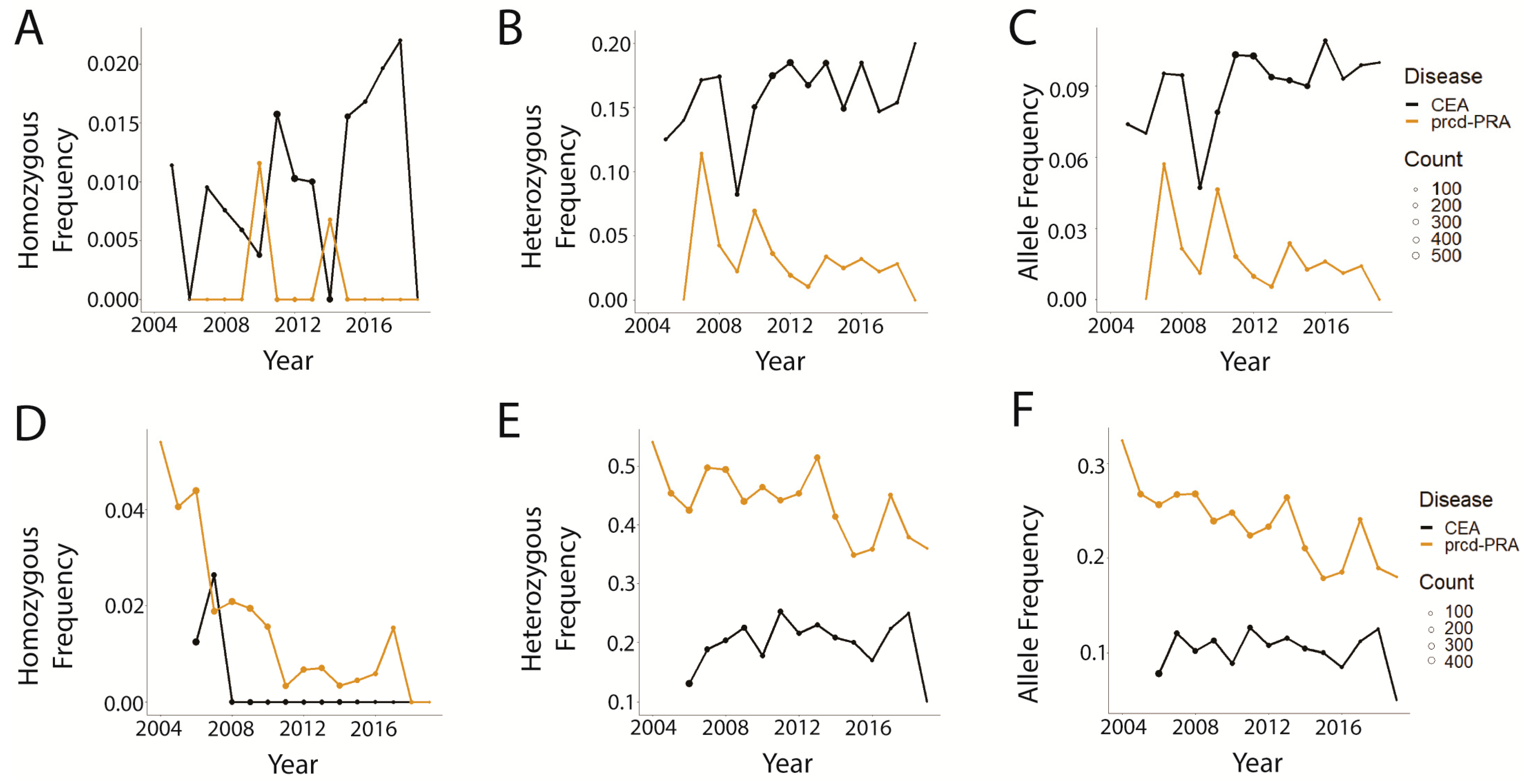
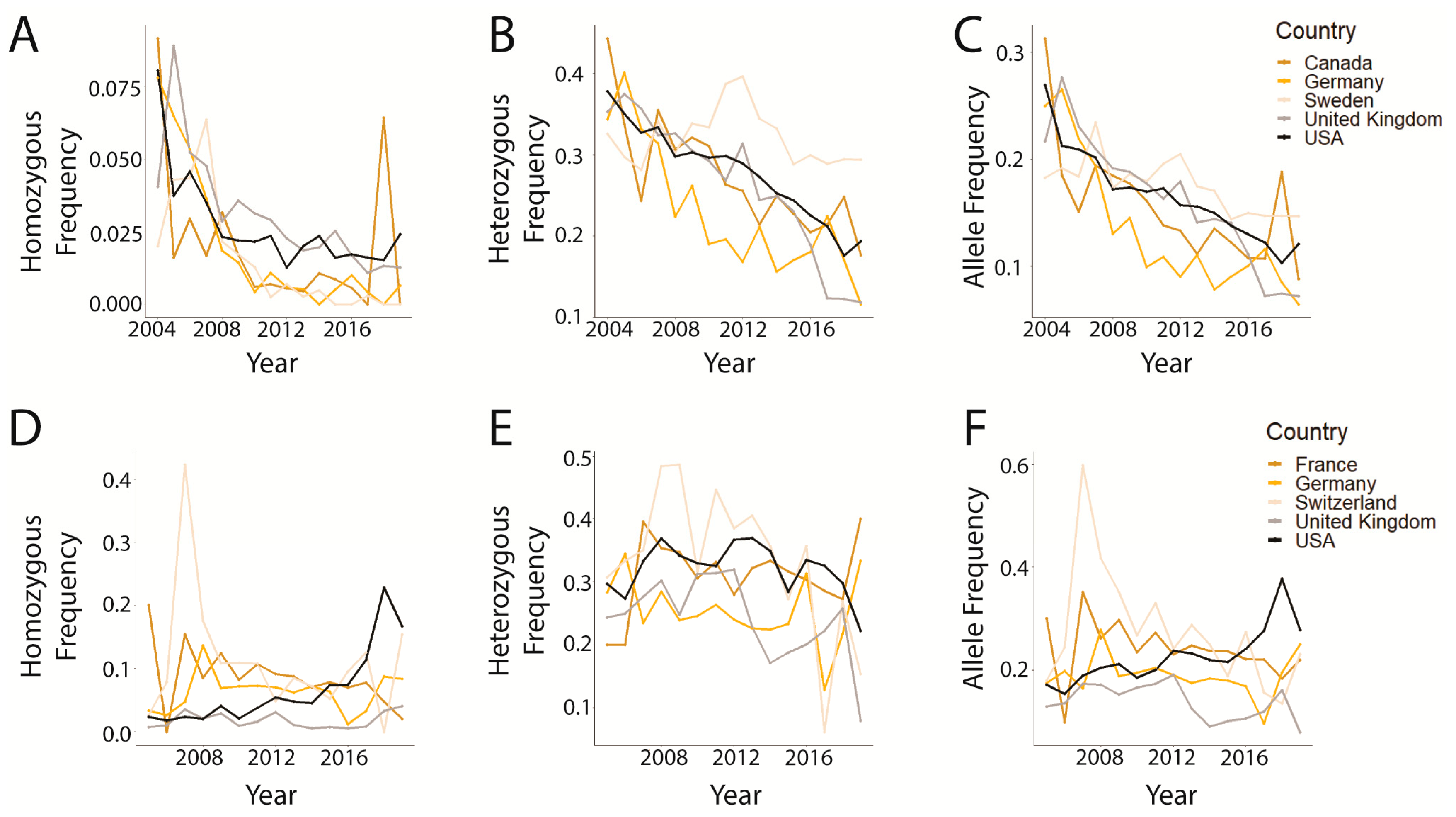
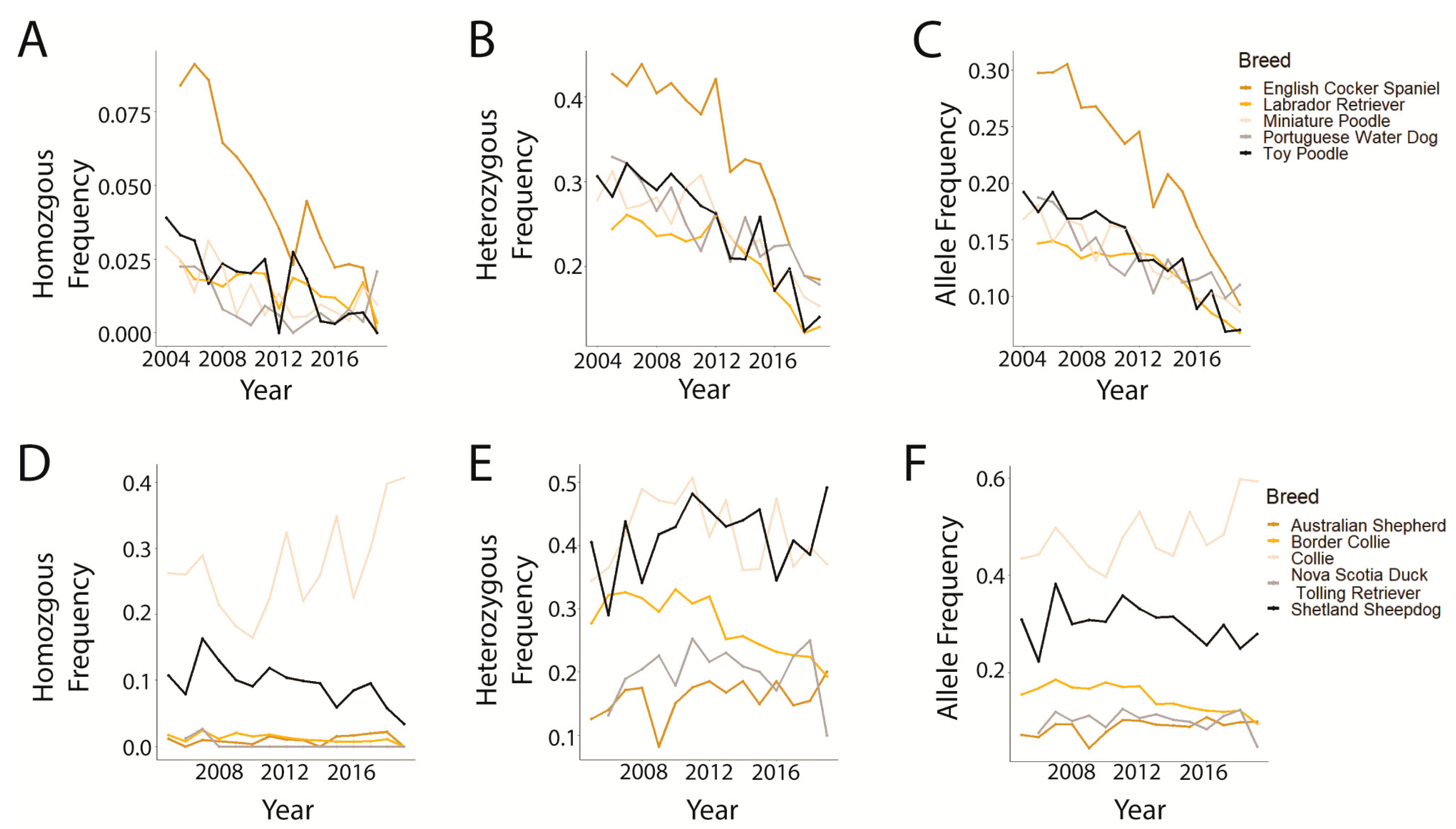

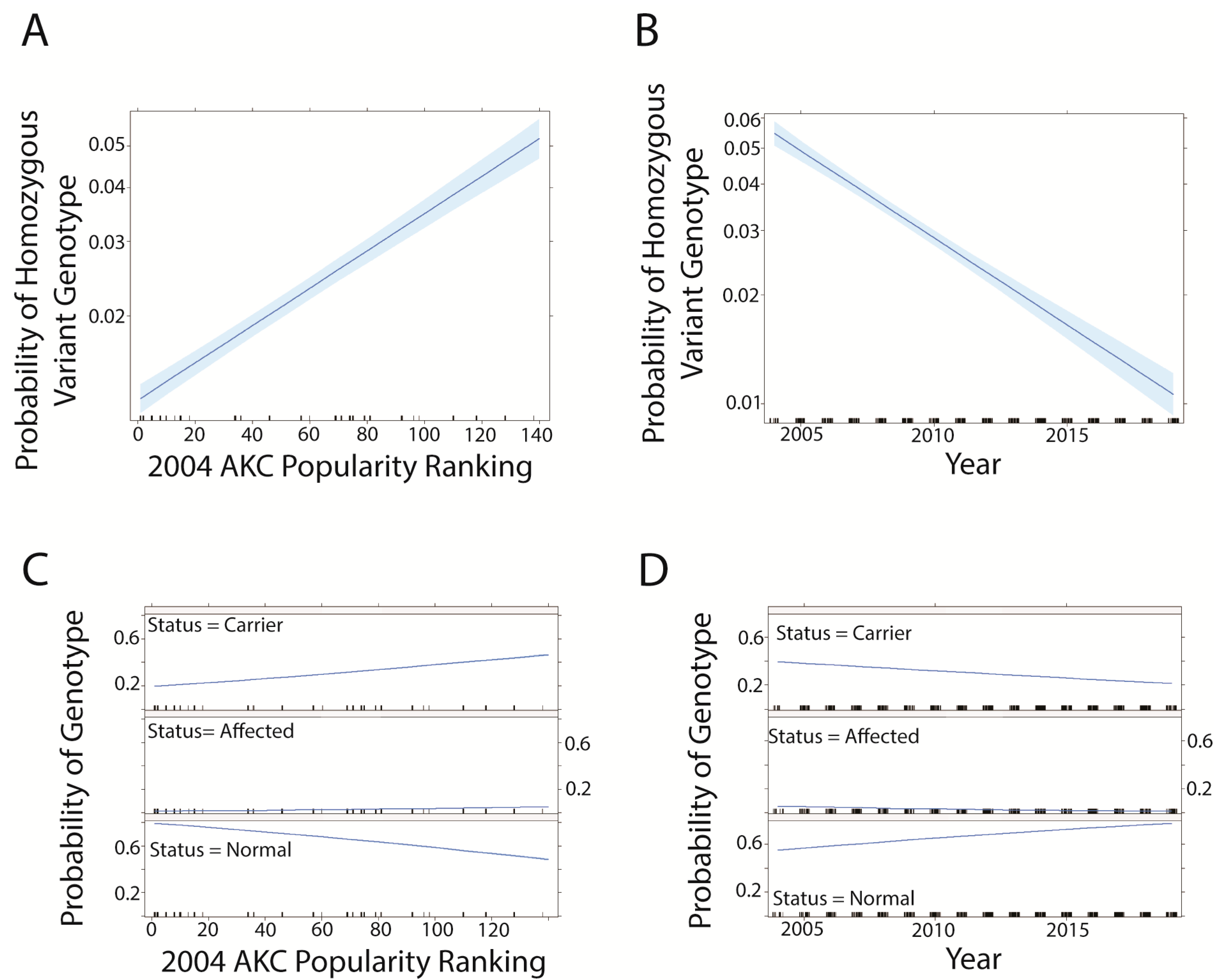

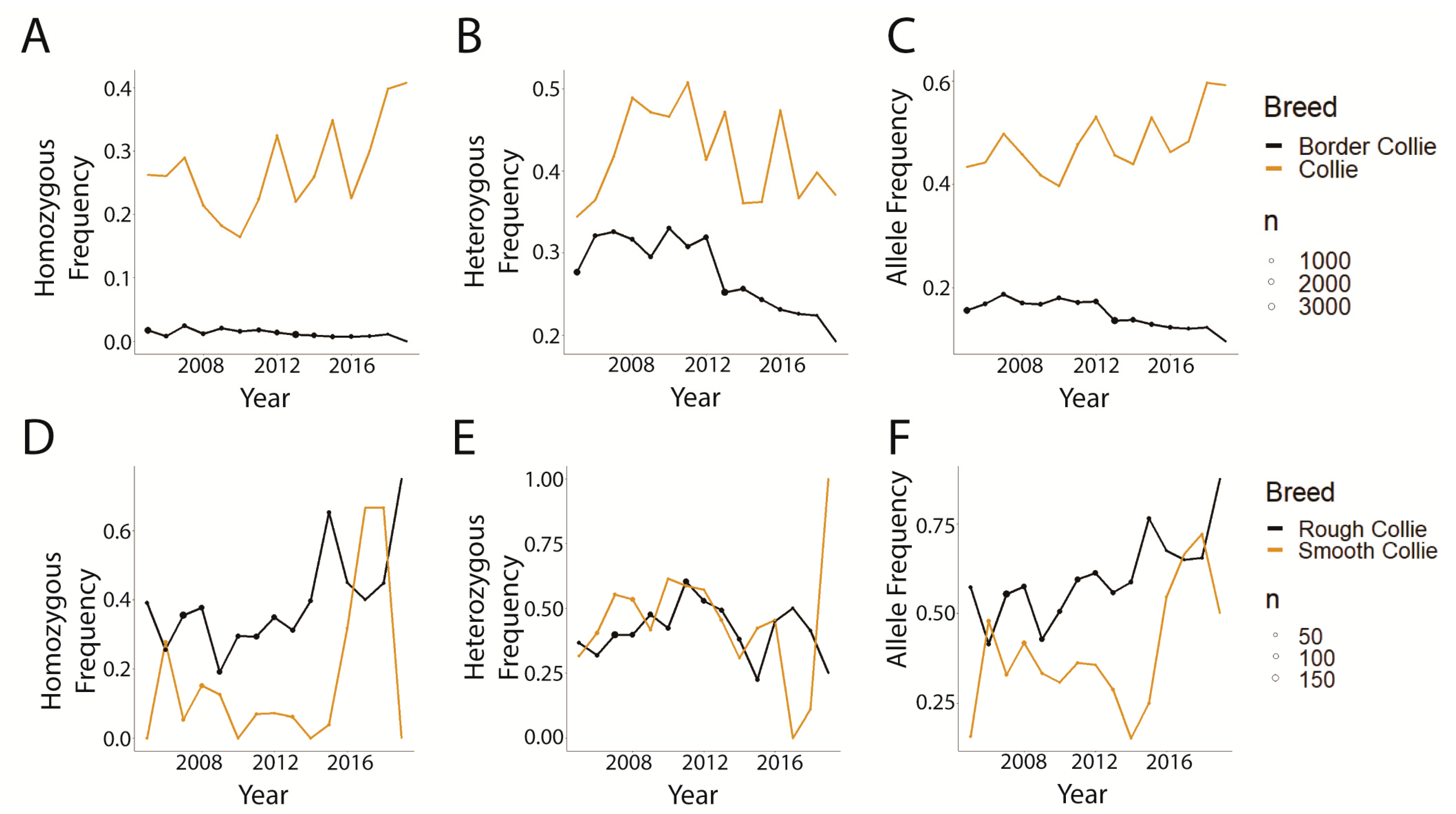


| X2 | p-Value | |
|---|---|---|
| prcd-PRA | 698.0194 | 2.7 × 10−152 |
| CEA | 7.52339 | 0.023244 |
| LRM for Affected Genotype (p-Value) | MRM for Genotype (SE) | MRM for Carrier Genotype (SE) | |
|---|---|---|---|
| prcd-PRA | −1.252 × 10−1 (<2 × 10−16) | −0.04864 (1.07 × 10−5) | −0.06331 (5.54 × 10−6) |
| CEA | −2.46 × 10−2 (0.00834) | −0.03438 (1.62 × 10−5) | −0.01948 (9.95 × 10−6) |
| Rank | LRM for Affected Genotype (p-Value *) | MRM for Affected Genotype (SE) | MRM for Carrier Genotype (SE) |
|---|---|---|---|
| 1 | Swedish Lapphund (4.65 × 10−5) | Swedish Lapphund (7.031 × 10−4) | Swedish Lapphund (4.300 × 10−3) |
| 2 | American Eskimo Dog (0.921564) | Entlebucher Mountain Dog (2.957 × 10−4) | American Eskimo Dog (3.057 × 10−5) |
| 3 | Entlebucher Mountain Dog (0.97598) | American Eskimo Dog (1.597 × 10−6) | Entlebucher Mountain Dog (1.865 × 10−3) |
| 4 | Australian Cattle Dog (0.955735) | Australian Cattle Dog (1.073 × 10−3) | Nova Scotia Duck Tolling Retriever (1.626 × 10−2) |
| 5 | English Cocker Spaniel (0.006659) | English Cocker Spaniel (2.299 × 10−3) | Australian Cattle Dog (6.342 × 10−3) |
| 6 | Spanish Water Dog (0.000362) | Nova Scotia Duck Tolling Retriever (6.288 × 10−4) | English Cocker Spaniel (2.005 × 10−2) |
| 7 | Finnish Lapphund (4.75 × 10−10) | Spanish Water Dog (2.990 × 10−5) | Labradoodle, Australian (1.363 × 10−3) |
| 8 | Nova Scotia Duck Tolling Retriever (<2 × 10−16) | Finnish Lapphund (7.442 × 10−5) | Dwarf Poodle (8.613 × 10−4) |
| 9 | Toy Poodle (<2 × 10−16) | Toy Poodle (1.058 × 10−3) | Finnish Lapphund (1.702 × 10−3) |
| 10 | Chesapeake Bay Retriever (4.31 × 10−8) | Chesapeake Bay Retriever (2.371 × 10−5) | Chesapeake Bay Retriever (6.065 × 10−4) |
| 11 | Labrador Retriever (<2 × 10−16) | Labrador Retriever (6.113 × 10−4) | Spanish Water Dog (6.533 × 10−4) |
| 12 | Miniature Poodle (<2 × 10−16) | Miniature Poodle (7.277 × 10−4) | Portuguese Water Dog (8.761 × 10−3) |
| 13 | Dwarf Poodle (3.16 × 10−6) | Dwarf Poodle (1.075 × 10−5) | Toy Poodle (2.562 × 10−2) |
| 14 | Portuguese Water Dog (<2 × 10−16) | Portuguese Water Dog (1.544 × 10−4) | Miniature Poodle (2.593 × 10−2) |
| 15 | Chinese Crested (<2 × 10−16) | Labradoodle, Australian (2.312 × 10−5) | Labrador Retriever (1.638 × 10−2) |
| 16 | Labradoodle, Australian (4.71 × 10−13) | Chinese Crested (1.439 × 10−5) | Golden Retriever (1.280 × 10−3) |
| 17 | Golden Retriever (<2 × 10−16) | Australian Shepherd (4.887 × 10−6) | Chinese Crested (5.514 × 10−4) |
| 18 | Australian Shepherd (1.64 × 10−9) | Golden Retriever (7.927 × 10−6) | Australian Shepherd (2.257 × 10−4) |
| Rank | LRM for Affected Genotype (p-Value *) | MRM for Affected Genotype (SE) | MRM for Carrier Genotype (SE) |
|---|---|---|---|
| 1 | Collie (<2 × 10−16) | Collie (1.633 × 10−2) | Collie (2.571 × 10−2) |
| 2 | Shetland Sheepdog (<2 × 10−16) | Shetland Sheepdog (8.510 × 10−3) | Shetland Sheepdog (2.396 × 10−2) |
| 3 | Border Collie (0.00067) | Border Collie (8.850 × 10−3) | Border Collie (2.293 × 10−2) |
| 4 | Australian Shepherd (0.96233) | Australian Shepherd (5.506 × 10−6) | Nova Scotia Duck Tolling Retriever (3.209 × 10−2) |
| 5 | Nova Scotia Duck Tolling Retriever (0.38093) | Nova Scotia Duck Tolling Retriever (3.634 × 10−4) | Australian Shepherd (3.693 × 10−5) |
Disclaimer/Publisher’s Note: The statements, opinions and data contained in all publications are solely those of the individual author(s) and contributor(s) and not of MDPI and/or the editor(s). MDPI and/or the editor(s) disclaim responsibility for any injury to people or property resulting from any ideas, methods, instructions or products referred to in the content. |
© 2023 by the authors. Licensee MDPI, Basel, Switzerland. This article is an open access article distributed under the terms and conditions of the Creative Commons Attribution (CC BY) license (https://creativecommons.org/licenses/by/4.0/).
Share and Cite
Clark, J.A.; Anderson, H.; Donner, J.; Pearce-Kelling, S.; Ekenstedt, K.J. Global Frequency Analyses of Canine Progressive Rod-Cone Degeneration–Progressive Retinal Atrophy and Collie Eye Anomaly Using Commercial Genetic Testing Data. Genes 2023, 14, 2093. https://doi.org/10.3390/genes14112093
Clark JA, Anderson H, Donner J, Pearce-Kelling S, Ekenstedt KJ. Global Frequency Analyses of Canine Progressive Rod-Cone Degeneration–Progressive Retinal Atrophy and Collie Eye Anomaly Using Commercial Genetic Testing Data. Genes. 2023; 14(11):2093. https://doi.org/10.3390/genes14112093
Chicago/Turabian StyleClark, Jessica A., Heidi Anderson, Jonas Donner, Susan Pearce-Kelling, and Kari J. Ekenstedt. 2023. "Global Frequency Analyses of Canine Progressive Rod-Cone Degeneration–Progressive Retinal Atrophy and Collie Eye Anomaly Using Commercial Genetic Testing Data" Genes 14, no. 11: 2093. https://doi.org/10.3390/genes14112093
APA StyleClark, J. A., Anderson, H., Donner, J., Pearce-Kelling, S., & Ekenstedt, K. J. (2023). Global Frequency Analyses of Canine Progressive Rod-Cone Degeneration–Progressive Retinal Atrophy and Collie Eye Anomaly Using Commercial Genetic Testing Data. Genes, 14(11), 2093. https://doi.org/10.3390/genes14112093





